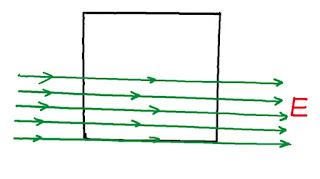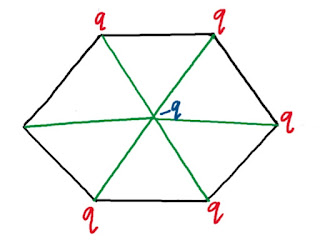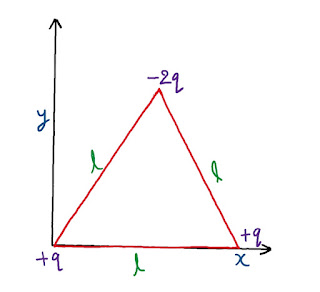Dear students numericals of electric charges and fields neet questions and electric charges and fields jee questions aiims important questions have been collected at one place to get you all prepared for your neet, aiims ,jee main, advance exams as well as cbse board exams and other board exams. Visit my nawendu classes youtube channel for more help.
 |
| electric charges and fields |
1. When ${{10}^{14}}$electron are removed from a neutral metal sphere ,the charge on the sphere becomes
Answer-16$\mu $C
2. How many electrons will a body loss or gain to acquire -1C charge ?
3. What is the force between two small charged spheres having charges of 2 × ${{10}^{-7}}$ C and 3 × ${{10}^{-7}}$ C placed 30 cm apart in air?
Answer- 6x${{10}^{-3}}$N (Repulsive)
4. Two similar small spheres having +q and -q charge are kept at a certain distance. F force acts between the two. If in the middle of two spheres, an another similar small sphere having +q charge is kept, then it will experience a force in magnitude and direction as
Answer- 8F towards -q charge
5. Two spherical conductors B and C having equal radii and carrying equal charges on them repel each other with a force F when kept apart at some distance. A third spherical conductor having same radius as that B but uncharged is brought in contact with B, then brought in contact with C and finally removed away from both. The new force of repulsion between B and C is
AIEEE 2004
Answer- 3F/8
6. \[{{F}_{g}}\] and \[{{F}_{e}}\] represents gravitational and electrostatic force respectively between electrons Situated at a distance 10cm. The ratio of $\frac{{{F}_{g}}}{{{F}_{e}}}$ is of the order of
Answer- ${{10}^{-42}}$
7. Two positive ions, each carrying a charge q. are separated by a distance d. If F is the force of repulsion between the ions, the number of electrons missing from each ion will be (e being the charge on an electron)
CBSE AIPMT 2010
Answer- $\sqrt{\frac{4\pi {{\varepsilon }_{0}}F{{d}^{2}}}{{{e}^{2}}}}$
9. 8. A charge Q is placed at each of the opposite corners of a square. A charge q is placed at each of the other two corners. If the net electric force on q is zero, then q/Q equals
Answer- -2√2
9. Four charges equal to Q are placed at the four corners of a square and a charge q is at its centre . It the system is in equilibrium the value of q is
Answer- $\frac{Q}{4}\times (1+2\sqrt{2})$
10. Two point charges qA = 3 $\mu $C and qB = –3 $\mu $C are located 20 cm apart in vacuum.(a) What is the electric field at the midpoint O of the line AB joining the two charges?(b) If a negative test charge of magnitude 1.5 × ${{10}^{-9}}$ C is placed at this point, what is the force experienced by the test charge?
Answer-(a)5.4x${{10}^{6}}$ N/C along OB (b)8.1x${{10}^{-3}}$N along OA
11.Two point charges of + 5 x ${{10}^{-19}}$C and + 20 x ${{10}^{-19}}$C are separated by a distance of 2 m. Find the point on the line joining them at which electric field intensity is zero.
Answer- 2/3 m to the right of first charge
12. The point charge Q and -2Q are placed at some distance apart. If the electric field at the location of Q is E, the electric field at the location of -2Q will be
Answer- –E/2
13. A particle of mass m and charge q is placed at rest in a uniform electric field E and then released. The kinetic energy attained by the particle after moving a distance y is
CBSE AIPMT 1998
Answer- qEy
14. There is
an electric field ( E) in X-direction.
If the work done in moving a charge 0.2 C
through a distance of 2m along a line making an angle 60 degree with X-axis
is 4J, the value of E is
Answer- 20N/C
15. The mean free path of electrons in metal is 4 x ${{10}^{-8}}$m. The electric field which can give on an average 2eV energy to an electron in the metal will be in units of V/m
CBSE- PMT 2009
Answer- 5 x ${{10}^{7}}$
16. Calculate the electric field strength required just to support a water drop of mass ${{10}^{ -7}}$kg and having a charge 1.6 x ${{10}^{-19}}$C
Answer- 6.125 x ${{10}^{12}}$N/C
17. A charged
oil drop is suspended in a uniform field of 3 x ${{10}^{4}}$ V/m so that it neither
falls nor rise. The charge on the drop will be (Take mass of the charged drop
= 9.9x${{10}^{-15}}$ kg and g=10 m/${{s}^{2}}$ )
Answer- 3.3
x${{10}^{-18}}$ C
18.A pendulum bob of mass 30.7 x ${{10}^{-6}}$kg and carrying a charge 2x${{10}^{-8}}$ C is at rest in a horizontal uniform electric field of 20000V/m. The tension in the thread of the pendulum is (g=9.8m/${{s}^{2}}$)
AIPMT 1990
Answer.-5 x ${{10}^{-4}}$ N
19.
A conducting sphere of radius 10cm is charged with 10$\mu $C.Another uncharged
sphere of radius 20cm is allowed to touch if for sometime. After that if
the spheres are separated, then surface density of charge on the spheres
will be in the ratio of
AIIMS 2002
Answer-
2:1
20. Two
spherical conductors A and B of radii 1mm and 2mm are separated by a distance
of 5cm and are uniformly charged. If the spheres are connected by the conducting wire then in equilibrium
condition, the ratio of the
magnitude of the electric field as the surfaces of the spheres A and B is
CBSE AIPMT 1992, AIEEE
2006
21. An oil drop of 12 excess electrons is held stationary under a constant electric field of 2.55 × ${{10}^{4}}$ N/C (Millikan’s oil drop experiment). The density of the oil is 1.26 g ${{cm}^{-3}}$. Estimate the radius of the drop. (g = 9.81 m ${{s}^{-2}}$; e = 1.60 × ${{10}^{-19}}$ C).
Answer-9.81x${{10}^{-4}}$mm
22.An electric dipole, consisting of two opposite charges of $2\times {{10}^{-6}}$ C each separated by a distance 3 cm is placed in an electric field of $2\times {{10}^{5}}$ N/C. Torque on the dipole is
CBSE AIPMT 1995
Answer- $12\times {{10}^{-3}}$ N-m
23. An electric dipole consists of two opposite charges each of magnitude 1.0 $\mu $ C separated by distance of 2.0cm. The dipole is placed in an external field of 1.0 x ${{10}^{5}}$ N/C. The maximum torque on the dipole is
Answer- 2.0 x ${{10}^{-3}}$ N-M
24. An electric
dipole is placed at an angle of 30 degree with an electric field intensity 2 x ${{10}^{5}}$
N/C.It experiences a
torque equal to 4 Nm. The charge on the dipole ,if the dipole length is 2cm, is
NEET 2016
00. The potential at a point x (measured in $\mu $ m) due to some charges situated on the x-axis is given by V(x) = 20/ (x2– 4) volt.The electric field E at x = 4 $\mu $ m is given by
AIEEE 2007
Answer- (10/9) V/$\mu $ m and in the +ve X direction
00. The electric potential V at any point x, y, z (all in metre) in space is given by $V=4{{x}^{2}}$volt. The electric field at the point (1m, 0, 2 m) is ......... V/m
IIT 1990, 1 M
Answer- $-8\hat{i}$
00. The electric potential at a point ( x,y,z ) is given by $V=-{{x}^{2}}y-x{{z}^{3}}+4$ . The electric field $\vec{E}$ at the point is
CBSE AIPMT 2009
Answer- $\vec{E}=\left( 2xy+{{z}^{3}} \right)\hat{i}+{{x}^{2}}\hat{j}+3x{{z}^{2}}\hat{k}$
00. In a region ,the potential is represented by $V\left( x,y,z \right)=6x-8xy-8y+6yz$. Where V in volts and x,y,z are in meters. The electric force experienced by a charge of 2 C situated at point (1,1,1) is
CBSE AIPMT 2014
Answer- $4\sqrt{35}$ N
25. A charge Q is enclosed by a Gaussian spherical surface of radius R. If the radius is doubled , then the outward electric flux will be
CBSE AIPMT 2011
Answer.- Reamain the same
26. A hollow
cylinder has a charge q within it. If $\varphi $ is the electric flux associated
with the curved surface B,
the flux linked with the plane surface A will be .
Answer.-$\frac{1}{2}(\frac{q}{{{\varepsilon
}_{0}}}-\varphi )$
27. A metallic solid sphere is placed in a uniform electric field . Which path is followed by the lines of force ?
IIT 1996
Answer.-path 4 is correct
28.In air, the value of the total electric flux emitted from unit positive charge is
AIIMS 2012
Answer.- $\varepsilon _{0}^{-1}$
29. A Square surface of side L metre in the plane of the paper is placed in a uniform electric field E(V/m) acting along the same place at an angle With the horizontal side of the square as shown in figure. The electric flux linked to the surface in unit of V-m, is
CBSE AIPMT 2010
Answer- 0
30. A square surface of side L meter is in the plane of the paper. A uniform electric field E ( V/m ), also in the plane of the paper, is limited only to the lower half of the square surface, (see figure). The electric flux in SI units associated with the surface is
CBSE AIPMT 2006
Answer- Zero
31. A charge q µC is placed at the centre of a cube of a side 0.1 m, then the electric flux diverging from each face of the cube is
CBSE AIPMT 2001
Answer- $\frac{q\times {{10}^{-6}}}{6{{\varepsilon }_{0}}}$
32. A charge Q $\mu $ C is placed at the center of a cube the flux coming out from any surface will be
Answer- $\frac{Q}{6{{\varepsilon }_{0}}}\times {{10}^{6}}$
33.A point charge +q is placed at mid-point of a cube of side L. The electric flux emerging from the cube is
CBSE AIPMT 1996
Answer- $\frac{q}{{{\varepsilon }_{0}}}$
34. A point charge of 2.0 $\mu $C is at the center of a cubic Gaussian surface 9.0 cm of edge. What is the net electric flux through the surface?
Answer- 1.9x${{10}^{5}}N{{m}^{2}}/C$
35. A charge q is placed at the corner of a cube of side a. The electric flux through the cube is
CBSE AIPMT 2000 ,2012
Answer- $\frac{q}{8{{\varepsilon }_{0}}}$
36. A point charge +10 µC is a distance 5 cm directly above
the centre of a square of side 10 cm, as shown in Figure. What is the
magnitude of the electric flux through the square? (Hint: Think of the square
as one face of a cube with edge 10 cm.)
Answer- 2.2x${{10}^{5}}N{{m}^{2}}/C$
37. If the electric flux entering and leaving an enclosed surface respectively is ${{\varphi }_{1}}$ and ${{\phi }_{2}}$ .The electric charge inside the surface will be
AIEEE 2003
Answer- $({{\varphi }_{2}}-{{\varphi }_{1}}){{\varepsilon }_{0}}$
38. A hollow insulated conducting sphere is given a positive charge of 10 µC. What will be the electric field at the centre of the sphere if its radius is 2 m?
CBSE AIPMT 1996
Answer- Zero
39.The electric field in a certain region is acting radially outward and is given by E = Ar. A charge contained in a sphere of radius 'a' centred at the origin of the field' will be given by
CBSE AIPMT 2015
Answer- $4\pi {{\varepsilon }_{0}}A{{a}^{3}}$
40.The electric field strength in air at NTP is $3\times {{10}^{6}}$ V/m. The maximum charge that can be given to a spherical conductor of radius 3 m is
CBSE AIPMT 1993
Answer- $3\times {{10}^{-3}}$C
41. Two parallel large thin mental charge sheets have equal surface charge densities ($\sigma =26.4\times {{10}^{-12}}C/{{m}^{2}}$ ) of opposite signs. The electric field between these sheets ,is
42. A hollow charged conductor has a tiny hole cut into its surface. Show that the electric field in the hole is ($\sigma /2{{\varepsilon }_{0}}$ ) $\overset{\wedge }{\mathop{n}}\,$ , where $\overset{\wedge }{\mathop{n}}\,$ is the unit vector in the outward normal direction, and σ is the surface charge density near the hole.
# Assertion and Reason
Direction -Read
the Assertion and Reason carefully to mark the correct
Option from
those given below
(a)Both
Assertion and Reason are true and Reason is the correct explanation of
(b)Both
Assertion and Reason are true but Reason is not the correct explanation of
(c)Assertion
is true but Reason is false
(d)Both
Assertion and Reason are false
43. Assertion –The
electric field due to a dipole on its
axial line at a distance r is E.
Then,
electric field due to the same dipole on the equatorial line and at the same
distance will be E/2.
Reason-
Electric field due to dipole varies inversely as the square of the distance.
AIIMS 2017
Answer- (C) Assertion
is true but Reason is false
44. Assertion -A
charge q is placed on a height h/4 above the centre of a square of side b. The flux
associated with the square is independent of side length.
Reason – Gauss’s
law is independent of the size of the Gaussian surface.
AIIMS 2015
Answer- (A)Both
Assertion and Reason are true and Reason is the correct explanation of
Assertion
45. Assertion-
A metallic shield in the form of a hollow shell may be build to block an
electric
Reason- in a
hollow spherical shield, the electric field inside it is zero at every point.
AIIMS 2012
Answer- (A)Both
Assertion and Reason are true and Reason is the correct explanation of Assertion
46. Assertion -A charged particle free to move in an electric field always moves along an
Reason -The
electric field lines diverge from a negative charge and converge at a positive
Answer- (d)Both
Assertion and Reason are false
47. Assertion -The
coulomb force is the dominating force in the universe.
Reason -The
Coulomb force is weaker than the gravitational force.
AIIMS 2003
Answer- (d)Both
Assertion and Reason are false
48. Charge q is uniformly distributed over a thin half ring of radius R. The electric field at the center of the ring is.
Answer- $\frac{q}{2{{\pi }^{2}}{{\varepsilon }_{0}}{{R}^{2}}}$
49. In a certain region of space, electric field is along the z-direction throughout. The magnitude of electric field is however not constant, but increases uniformly along the positive z-direction at the rate of ${{10}^{5}}$ $N{{C}^{-1}}{{m}^{-1}}$ . The force experienced by the system having a total dipole moment equal to ${{10}^{-7}}$ Cm in the negative z-direction is.
Answer- ${{10}^{-2}}$ N
50. Two pith balls carrying equal charges are suspended from a common point by strings of equal length, the equilibrium separation between them is r. Now, the strings are rigidly clamped at half the height. The equilibrium separation between the balls now becomes
NEET 2013
Answer- $\frac{r}{\sqrt{2}}$
51. A charge q is placed at the center of the line joining two equal charges Q. The system of the three charges will be in equilibrium if q is equal to
IIT 1987,2M ,CBSE AIPMT 1995
Answer.- -Q/4
52.Three charges +Q, q , +Q are placed respectively at distance 0, d/2 and d from the origin on the X-axis . if the net force experienced by +Q placed at x=o is zero , then
Value of q is
IIT Main 2019, 9 jan shift 1
53. An electron of mass $\mathop{m}_{e}$ initially at rest ,moves through a certain distance in a uniform electric field in time $\mathop{t}_{1}$.A proton of mass $\mathop{m}_{p}$ ,also ,initially at rest ,takes time $\mathop{t}_{2}$ to move through an equal distance in this uniform electric field . Neglecting the effect of gravity , the ratio $\mathop{t}_{1}$ /$\mathop{t}_{2}$ is nearly equal to
IIT 1997,1M
Answer.- $\sqrt{{\mathop{m}_{p}}/{\mathop{m}_{e}}\;}$
54. Five point charges,
each of value +q coulomb, are placed on five vertices of a regular hexagon of
side L metre . The magnitude of the force on the point charge of value -q
coulomb at the centre of the hexagon is ………..newton.
IIT 1992, 1 M
Answer- $\frac{1}{4\pi {{\varepsilon
}_{0}}}.\frac{{{q}^{2}}}{{{L}^{2}}}$
55. Determine the electric dipole moment of the system of
three charges, placed on the vertices of an equilateral triangle as shown in
the figure.
IIT Main 2019, 12 Jan I
Answer- $-\sqrt{3}ql\hat{j}$
56. Obtain the formula for the electric field due to a long thin wire of uniform linear charge density E without using Gauss’s law. [Hint: Use Coulomb’s law directly and evaluate the necessary integral.]
57. A charged wire is bent in the form of a semicircular arc of radius a. If charge per unit length is λ coulomb/metre, the electric field at the centre O is
CBSE AIPMT 2000
Answer- $\frac{\lambda }{2\pi {{\varepsilon }_{0}}a}$

.jpeg)

.jpeg)















No comments